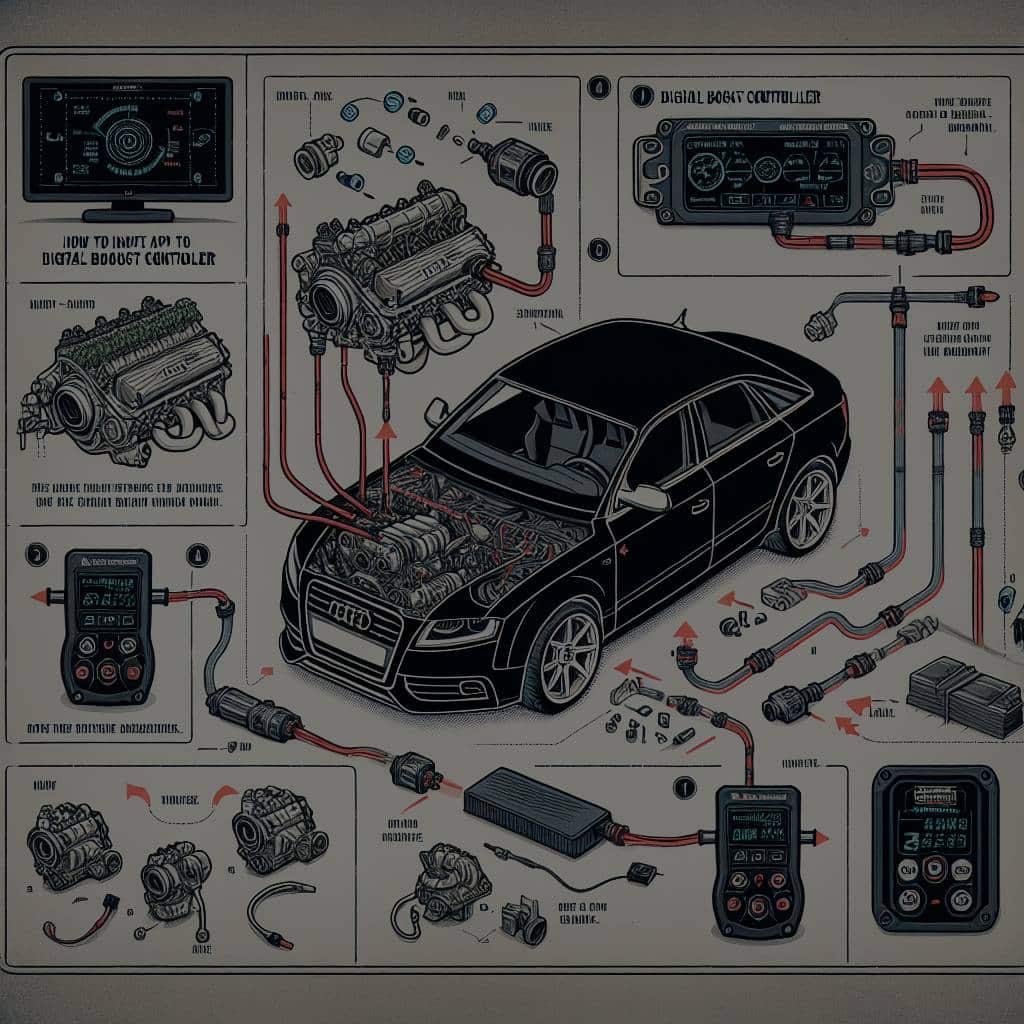It’s a sunny afternoon, you’re in your garage and you just can’t resist the allure of your Audi S4. You know it’s not only about the sleek lines and plush interior. It’s about that powerful engine humming under the hood, the turbocharged TFSI power plant that makes your automotive heart race. But you want more. You want to take control and squeeze every bit of performance out of your car. You want to install a digital boost controller.
Before diving into the installation process, it’s important to understand what a digital boost controller is and why you need one in your Audi S4. A digital boost controller will help you manage the pressure of your turbo system to avoid over-boosting. At the same time, it can increase the performance of your car by allowing the turbo to reach its full potential.
Also to discover : What Are the Best Mud Tires for a Land Rover Defender for Off-Road Adventures?
What is a Digital Boost Controller?
A digital boost controller is an essential tool for any car enthusiast that wants to improve the performance of their turbocharged vehicle. It is used to control the amount of air pressure that is sent to the turbo, which in turn controls how much boost the engine is receiving. This control is essential as too much boost can damage the engine, and not enough can reduce performance.
The digital boost controller lets you set a specific boost level and will adjust the pressure to maintain that level throughout the entire RPM range. This ensures consistent power and performance, which is crucial when racing or just looking for an exhilarating drive.
Additional reading : What Are the Steps to Safely Increase Boost on a Saab 9-3 Aero Turbo?
Why Install a Digital Boost Controller in an Audi S4?
Your Audi S4, like many high-performance cars, comes with a factory-set turbo system. While this is more than capable of delivering a robust and satisfying driving experience, there are limitations. The system is designed to balance performance, fuel economy, and emissions. However, as an enthusiast, you might be willing to sacrifice a bit of fuel economy for more power.
Installation of a digital boost controller allows for precise control of the turbo system. By manipulating the pressure valve, you can increase the boost to improve engine performance. Furthermore, you are able to maintain this boost at a higher RPM, which in effect gives your Audi S4 an extra kick of power when you need it most.
Selecting the Right Digital Boost Controller
Before heading to the market, you need to understand that not every digital boost controller is created equal. Some controllers are specifically designed for certain types of cars, while others offer more advanced features such as data logging and dual stage boost control.
When choosing a digital boost controller for your Audi S4, make sure it is compatible with your car’s turbo system. The controller should operate in a range that is suitable for your car’s boost pressure. Moreover, it should have an interface that is easy to use, preferably with a clear display and intuitive controls.
How to Install a Digital Boost Controller
Now that you have selected the right digital boost controller for your Audi S4, it’s time to install it. Although the process can seem daunting, if you follow these steps, you will have your digital boost controller up and running in no time.
-
Locate the Turbo Pressure Source: The first step is to locate the turbo pressure source in your Audi S4. This is typically a small pipe or fitting on the turbo or intake manifold.
-
Mount the Controller: Decide on a location to mount the controller where it can be easily accessed. Ensure it is securely fastened to avoid any movement or vibration during operation.
-
Connect the Wires: Connect the power and ground wires to the controller as per the manufacturer’s instructions. Make sure these connections are secure and well insulated to avoid any electrical issues.
-
Install the Boost Solenoid: The boost solenoid is what allows you to control the pressure in the turbo system. It should be installed in the engine bay, close to the turbo pressure source. It is important to ensure that the solenoid is connected properly to avoid any damage.
-
Connect the Solenoid to the Controller: The final step is to connect the boost solenoid to the digital boost controller. This is typically done using a vacuum line. Ensure that the connection is secure and there are no leaks.
After installation, it’s crucial to test the system to ensure that it’s working correctly. Start your Audi S4 and let it idle. Watch the digital display on the controller as the car warms up. It should be fluctuating slightly as the turbo pressure changes with the engine’s RPM.
Finally, take your Audi S4 for a test drive. Pay attention to the feel of the acceleration and the responsiveness of the throttle. If everything is installed correctly, you should notice a significant increase in performance, especially at higher RPMs.
In the world of car performance and racing, control is everything. A digital boost controller is one of the best ways to take control of your turbocharged Audi S4. Not only will it enhance your car’s performance, but it also allows you to tailor the driving experience to your exact preferences. After all, who wouldn’t want to have total control over their car’s power?
Understanding the Important Components and Their Functions
Before diving into the installation process, it is essential to comprehend the role and function of each component involved. This knowledge will provide you with a better understanding of how the system works, making the installation process smoother and less daunting.
Boost Controllers essentially regulate the amount of air pressure in the turbo system. They prevent over-boosting, which can be harmful to the engine, and also ensure consistent performance by maintaining a set boost level throughout the RPM range.
The Diverter Valve, also known as a blow-off valve, releases excess boost pressure when the throttle is closed. This prevents damage to the turbocharger and ensures smooth transitions between gears.
The Boost Control Solenoid, controlled by the boost controller, is responsible for regulating the boost pressure. It opens or closes to allow more or less air into the turbo system based on the preset boost level.
The Map Sensor measures the amount of air pressure and temperature in the intake manifold. This information is then sent to the engine control unit (ECU) to adjust fuel injection and ignition timing for optimal performance.
Turbo Lag, a common issue in turbocharged cars, is the delay between the driver’s input on the throttle and the turbo’s response. A digital boost controller can help minimize this lag, improving throttle response and overall driving experience.
Big Turbo upgrades can dramatically increase power, but they also increase the complexity of the system and the importance of precise control. Whether you’re running an OEM diverter or have moved up to a high performance big turbo system, the right boost controller is critical.
Digital Boost Controller Installation: Troubleshooting and Maintenance
Once your digital boost controller is installed and tested, it’s important to understand that the job isn’t over. Regular maintenance and troubleshooting are necessary to ensure the system continues to operate effectively and safely.
If you notice any issues such as inconsistent boost levels, poor throttle response, or a decrease in performance, it’s time to do some troubleshooting. Start by checking the boost controller settings. Make sure they’re set correctly and haven’t been accidentally altered.
Next, inspect the boost control solenoid and diverter valve. Look for any signs of damage or wear and ensure they’re functioning properly.
Also, inspect the vacuum lines connecting the components. Check for any cracks, leaks, or loose connections that could be affecting the boost pressure.
Finally, remember to keep an eye on your fuel pressure. With increased boost levels, the fuel requirements of your TFSI Audi engine also increase. It’s important to ensure your fuel system can deliver the necessary fuel to maintain a proper air-fuel ratio and prevent damage to your engine.
Conclusion
The installation of a digital boost controller in an Audi S4 is an exciting and rewarding project that can significantly enhance your car’s performance. With the right understanding, careful installation, and regular maintenance, you’ll enjoy a more responsive, powerful, and thrilling driving experience.
Whether you’re an experienced car enthusiast looking to minimize turbo lag, increase throttle response, or simply gain greater control over your vehicle, a digital boost controller is a worthy investment. With the ability to precisely manage the boost pressure in your turbo system, you can tailor your Audi S4’s performance to your exact preferences, ensuring every drive is as exhilarating as the last.
Remember, control is the key. The more control you have, the better you can tune your car’s performance and the more enjoyment you’ll get out of driving your turbocharged Audi S4. Happy boosting!






